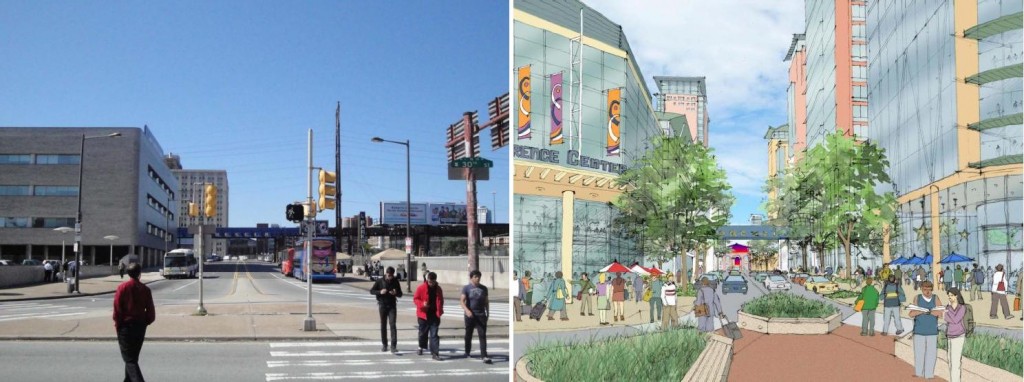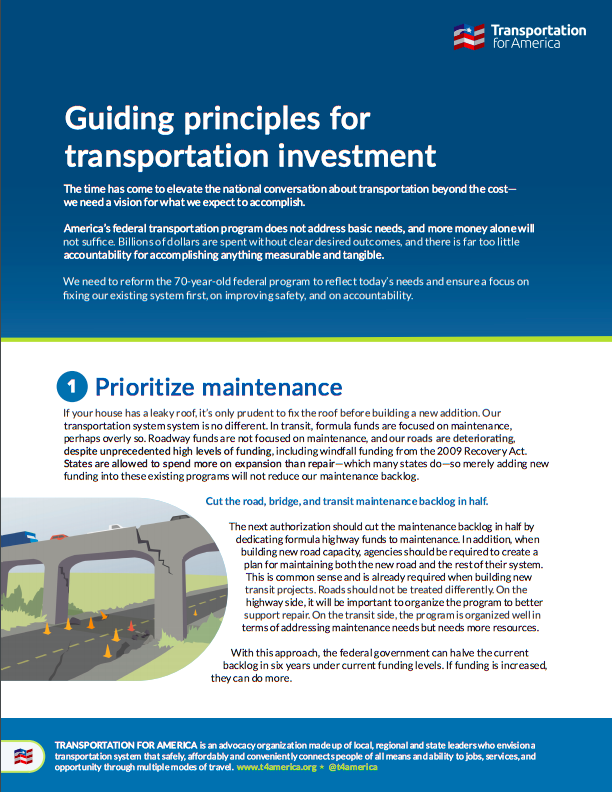Competitive grant programs in PA and OR provide a blueprint for a different approach
There’s strong support for a plan in Congress to give locals more access to their transportation dollars, but two states are already leading the way on the idea of competitive grants for smart projects — and Pennsylvania took a big step today.

A photo of current conditions and a rendering from the campus master plan for Drexel University around 30th Street Station in Philadelphia, one of the grantees. More info below.
The Pennsylvania DOT today announced the initial winners of a new statewide competitive grant program specifically for multimodal projects and the impressive list shows just how much demand there is at the local level for these types of innovative projects.
Pennsylvania was one of 12 states that managed to successfully raise new transportation revenue over the last couple of years, but they went a step beyond just raising funds to pour into the same old projects or plug budget gaps. After changing their transportation funding structure, they directed a portion of the new money raised each year into a new, statewide, multimodal grant program.
The first round of winners totaling $84 million is an impressive collection of roadway, freight and passenger rail, aviation, port and waterway, bicycle and pedestrian safety, and other projects. Every single applicant has their own financial skin in the game, bringing significant local or private money to the table.
That last detail is important — applicants are required to have 30 percent of the total cost in hand from other sources to even be considered for receiving state funds. By contrast, traditional federal formula funds only require a 20 percent match. And unlike most other grant programs, private entities can apply and win funding (more on one of those below), which means private money can be brought to bear on improving the transportation system.
Pennsylvania is not the first to create a program like this. In 2005, Oregon successfully created a program called ConnectOregon, which has received more than 528 applications and awarded $482 million in grants since the program’s inception. In just the first four rounds of competitive grants, $340 million in grants for multimodal projects leveraged an additional $500 million in non-state funds.
One thing that local elected officials like to hear is that these programs in PA or OR (or the potential programs in every state that Congress’ Innovation in Surface Transportation Act would create) are equally accessible to rural and urban areas.
Even if you’re a smaller city, the eligibility is the same: Do you have a good project that hits all the competitive criteria from the state? Does your project bring a strong return on investment? Are you bringing your own money to the table? Then you’ve got as good a chance to win funding as a big project in Philadelphia.
Mayors and elected officials throughout the country are looking for an opportunity to compete for funds — especially those that are too often left out of the decision-making process. Representatives in both chambers of Congress have taken these concerns to heart and incorporated some of the best qualities of these two state programs into The Innovation in Surface Transportation Act, which has strong bipartisan support in both the House and Senate.
Pore over the list of winners in Pennsylvania announced today and it’s obvious just how much pent-up demand there is to get funding for smart, innovative local projects. One project in Pittsburgh stands out from the typical winners you see in TIGER, because it’s a private entity. The Oxford Development Company received $2.2 million to augment a development project that will bring tangible benefits to the transportation network in the neighborhood and for the city. Oxford has a $130 million plan to develop Three Crossings, a mixed-use development in the Strip District that will include a multimodal transportation facility on-site and improved bike and pedestrian connections into that historic walkable neighborhood just north of downtown.
A few others worth noting:
- Port Authority of Allegheny County, McKeesport – $1 million to demolish the existing McKeesport Transportation Center and build a new multimodal terminal that will bring together regional and local buses, vans, and ACCESS paratransit, a park-and-ride lot, and a major bicycle trail. (Photos of the current station)
- Drexel University, Philadelphia – $2.5 million to create an integrated plan to address transportation, commercial opportunities and the station and facilities in the area around Philadelphia’s bustling 30th Street Station. (Photo from the Drexel Master Plan below)
- Erie Regional Airport Authority, Millcreek Township – $700,000 for improvements to the Erie International Airport terminal building.
- Economic Progress Alliance of Crawford County, Greenwood Township – $1 million to construct an 85-car unit train loop track in the Keystone Regional Industrial Park that will allow a an 85-car train to be serviced, unloaded and turned around at the Keystone Regional Industrial Park without having to uncouple its engine or cars. The state’s $1 million contribution will make it possible for this $7.2 million project to proceed. Story.
- Big Spring School District, West Pennsboro Township – $525,000 to complete pedestrian safety improvements, including the design of a pedestrian tunnel connecting Big Spring High School with the fitness center and middle school located across the street in this small town.






Pingback: Ohio DOT Hosts Transit Meeting That No One Can Reach Via Transit | Streetsblog.net